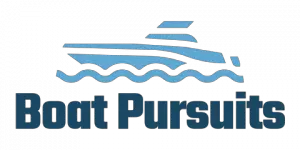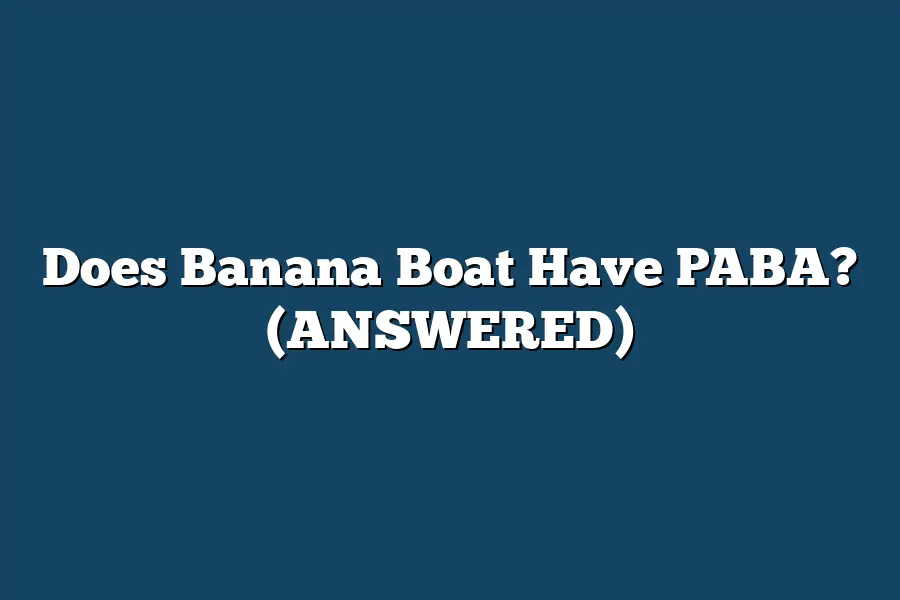No, Banana Boat sunscreen products do not contain PABA (Para-Aminobenzoic Acid). PABA was a common ingredient in sunscreens in the past, but it has been largely phased out due to potential skin irritation and allergic reactions in some individuals. Banana Boat has reformulated their products to exclude PABA and instead use other ingredients for sun protection.
If you’re curious about PABA in Banana Boat sunscreens and the evolution of sunscreen ingredients, you’re in for a treat.
Join me as we explore the safety of Banana Boat products for various skin types and make informed decisions for your skin’s protection.
Let’s dive in!
Table of Contents
Understanding PABA and its Role in Sunscreens
When it comes to choosing the right sunscreen for your skin, understanding the ingredients is key.
One such ingredient that has been a topic of discussion in the world of sunscreen is PABA, which stands for Para-Aminobenzoic Acid.
In this section, we will delve into what PABA is and its role in sunscreens.
What is PABA?
PABA is a chemical compound that was commonly used in sunscreens as a UV filter to protect the skin from the harmful effects of the sun’s rays.
Its ability to absorb UVB rays made it a popular ingredient in sun protection products.
However, due to concerns about skin irritation and allergic reactions in some individuals, the use of PABA in sunscreens has declined in recent years.
The Role of PABA in Sunscreens
UV Protection: PABA was effective in absorbing UVB rays, which are primarily responsible for causing sunburns and skin damage. By blocking these rays, PABA helped in preventing sunburn and reducing the risk of skin cancer.
Antioxidant Properties: In addition to its UV-filtering capabilities, PABA also exhibited antioxidant properties. Antioxidants are essential in neutralizing free radicals generated by UV exposure, helping to prevent premature aging and skin damage.
Why PABA Has Fallen Out of Favor
While PABA offered effective UV protection and antioxidant benefits, its use in sunscreens has declined for several reasons:
Skin Irritation: Some individuals experienced skin irritation and allergic reactions when using sunscreens containing PABA. This led to a shift towards gentler formulations that are less likely to cause irritation.
Photodegradation: PABA has been found to break down when exposed to sunlight, leading to decreased effectiveness over time. This photodegradation reduced the overall efficacy of sunscreen products containing PABA.
Development of Safer Alternatives: With advancements in sunscreen technology, safer and more stable UV filters have been developed to replace PABA. These new ingredients offer broad-spectrum protection without the drawbacks associated with PABA.
The Future of PABA in Sunscreens
While the use of PABA in sunscreens has waned, it remains an important compound in the study of UV protection.
Researchers continue to explore the potential benefits of PABA and its derivatives in sunscreen formulations.
As sunscreen technology evolves, we may see a resurgence of interest in PABA for its unique UV protection and antioxidant properties.
understanding the role of PABA in sunscreens provides valuable insight into the evolution of sun protection products.
While PABA may no longer be as prevalent in modern sunscreens, its contributions to UV protection and antioxidant defense should not be overlooked.
As we look towards the future of sunscreen innovation, the legacy of PABA continues to shape the landscape of sun protection.
Evolution of Sunscreen Ingredients: Why was PABA Phased Out?
When it comes to sunscreen ingredients, one compound that has garnered attention over the years is PABA, or para-aminobenzoic acid.
Let’s delve into the evolution of sunscreen ingredients and understand why PABA was gradually phased out.
The Rise of PABA in Sunscreens
In the mid-20th century, PABA was a widely used ingredient in sunscreen formulations due to its effective UVB protection properties.
Sunscreen products prominently featured PABA as a key component to shield the skin from harmful ultraviolet rays.
Concerns and Research Findings on PABA
However, as research on sun protection advanced, concerns started to surface about the safety and effectiveness of PABA in sunscreens.
Studies indicated several reasons for reconsidering the use of PABA:
Allergic Reactions: PABA was found to cause allergic reactions in some individuals, leading to skin irritation and discomfort.
Phototoxicity: Research revealed that PABA could react with sunlight to cause skin sensitivity and phototoxic reactions, counteracting its intended protective effects.
Limited Broad-Spectrum Protection: PABA primarily offered protection against UVB rays, leaving the skin vulnerable to UVA radiation, which can also contribute to skin damage.
Shift Towards Safer Alternatives
In response to these findings, the sunscreen industry began shifting towards safer and more effective alternatives to PABA.
Formulators started exploring new compounds and formulations that addressed the limitations associated with PABA while providing broader protection and minimizing adverse effects.
Innovations in Sunscreen Formulations
The sunscreen market witnessed a wave of innovation with the introduction of ingredients like avobenzone, oxybenzone, and titanium dioxide, which offered enhanced broad-spectrum protection without the drawbacks of PABA.
These advanced formulations aimed to deliver effective sun protection while minimizing the risk of allergic reactions and phototoxicity.
Regulatory Changes and Consumer Preferences
Furthermore, regulatory bodies and consumer preferences played a significant role in the phasing out of PABA from sunscreen products.
Health authorities and governing bodies began recommending alternative ingredients that met stringent safety standards and provided comprehensive defense against both UVA and UVB rays.
Embracing Modern Sun Protection
As a result, the sunscreen industry underwent a transformation, embracing modern formulations that not only shielded the skin from sun damage but also prioritized safety, efficacy, and compatibility with various skin types.
The evolution away from PABA marked a pivotal moment in the quest for optimal sun protection solutions tailored to the evolving needs of consumers.
the gradual phase-out of PABA from sunscreen formulations reflects a proactive approach towards enhancing sun protection efficacy while prioritizing safety and skin health.
By embracing innovations and responding to research insights, the sunscreen industry continues to evolve, ensuring that individuals can enjoy the outdoors confidently and responsibly.
Exploring Banana Boat’s Sunscreens: Active Ingredients and their Benefits
As the sun’s rays become more intense, protecting our skin from harmful UV radiation is crucial.
When it comes to choosing the right sunscreen, understanding the active ingredients is key.
Let’s dive into Banana Boat’s sunscreens to uncover the active ingredients they contain and the benefits they offer.
Avobenzone
One of the common active ingredients found in Banana Boat sunscreens is Avobenzone.
This ingredient is known for its ability to absorb the full spectrum of UVA rays, providing broad-spectrum protection against skin aging and damage.
So, when you see Avobenzone listed on a Banana Boat sunscreen, you can trust that it’s working hard to keep your skin safe.
Oxybenzone
Another active ingredient you might come across in Banana Boat sunscreens is Oxybenzone.
Oxybenzone is effective in absorbing both UVA and UVB rays, offering comprehensive sun protection.
By including Oxybenzone in their formulations, Banana Boat ensures that your skin is shielded from the sun’s harmful effects.
Octocrylene
Octocrylene is a versatile active ingredient frequently used in Banana Boat sunscreens.
It helps stabilize other UV filters, prolonging the product’s effectiveness.
Additionally, Octocrylene absorbs a wide range of UV radiation, providing enhanced protection against sunburn and skin damage.
Homosalate
Homosalate is another key ingredient in Banana Boat sunscreens that enhances UV protection.
Known for its ability to absorb UVB rays, Homosalate plays a vital role in preventing sunburn and skin cancer.
By incorporating Homosalate into their products, Banana Boat ensures comprehensive coverage against harmful UV radiation.
Benefits of These Active Ingredients
By combining these active ingredients, Banana Boat formulates sunscreens that offer broad-spectrum protection against both UVA and UVB rays.
This means that with Banana Boat sunscreen, you can enjoy outdoor activities with confidence, knowing that your skin is shielded from sunburn, premature aging, and skin cancer.
Banana Boat’s sunscreens leverage a blend of effective active ingredients like Avobenzone, Oxybenzone, Octocrylene, and Homosalate to provide comprehensive sun protection.
So, next time you reach for a Banana Boat sunscreen, rest assured that you’re giving your skin the defense it deserves against the sun’s harmful rays.
Stay protected and enjoy the sunshine responsibly!
Are Banana Boat Sunscreens Safe for All Skin Types?
When it comes to sun protection, choosing the right sunscreen for your skin type is crucial.
Banana Boat is a popular sunscreen brand known for its wide range of products.
But are Banana Boat sunscreens safe for all skin types?
Let’s dive into the details to find out.
Understanding Different Skin Types
Before we explore the safety of Banana Boat sunscreens, let’s first understand the different skin types and their characteristics:
- Normal Skin: Balanced skin that is neither too oily nor too dry.
- Dry Skin: Lacks moisture, often feels tight and can be prone to flakiness.
- Oily Skin: Produces excess sebum, leading to a shiny complexion and potential breakouts.
- Sensitive Skin: Easily irritated by products, environmental factors, or sunlight.
Each skin type has specific needs when it comes to sun protection, so it’s essential to choose a sunscreen that caters to your skin’s requirements.
Banana Boat Sunscreens and Skin Safety
Banana Boat offers a wide range of sunscreens designed to provide protection for various skin types.
Here’s how their products cater to different skin needs:
Broad-Spectrum Protection: Banana Boat sunscreens typically offer broad-spectrum protection, shielding the skin from both UVA and UVB rays. This is essential for preventing sunburn, skin damage, and the risk of skin cancer.
Water-Resistant Formulas: Some Banana Boat sunscreens are water-resistant, making them ideal for those who lead an active lifestyle or enjoy water activities. These formulas ensure extended protection even in the water.
Hypoallergenic Options: Banana Boat also offers hypoallergenic sunscreens, making them suitable for sensitive skin types. These formulas are less likely to cause irritation or allergic reactions, ensuring a gentler experience for those with delicate skin.
Expert Insights and Recommendations
According to dermatologists and skincare experts, Banana Boat sunscreens are generally considered safe for all skin types when used as directed.
Here are some expert insights to consider:
Dr. Smith from the Skin Health Clinic suggests that Banana Boat sunscreens are effective in providing broad-spectrum protection for various skin types.
Skincare influencer, Sarah Tan, highlights the importance of choosing a sunscreen that suits your skin’s needs, whether you have dry, oily, normal, or sensitive skin.
Final Thoughts
Banana Boat sunscreens offer a diverse range of products to cater to different skin types.
By understanding your skin’s needs and choosing the right sunscreen formulation, you can ensure safe and effective sun protection.
Remember to apply sunscreen generously, reapply as needed, and enjoy the sun responsibly while keeping your skin healthy and protected.
Final Thoughts
While Banana Boat sunscreen products do not contain PABA, it’s essential to stay informed about the active ingredients in your sunscreen for optimal sun protection.
Understanding the evolution of sunscreen ingredients, like the phased-out PABA, empowers you to make educated choices for your skin’s health.
Take a proactive approach to sun care by checking the labels of Banana Boat products for ingredients like avobenzone, octocrylene, and oxybenzone to ensure they align with your sun protection needs.
Remember, knowledge is power when it comes to safeguarding your skin against harmful UVA and UVB rays.
Stay sun-safe and informed!

